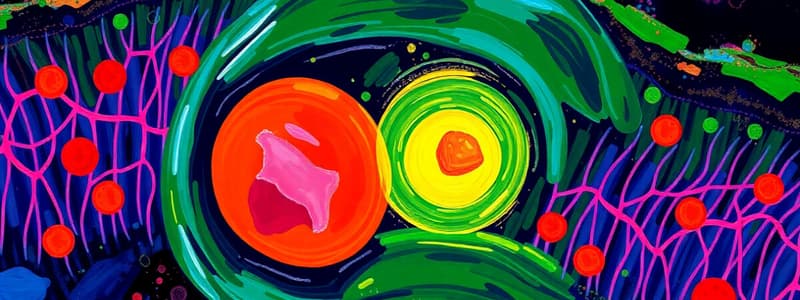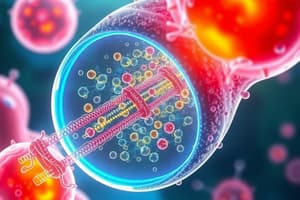Podcast
Questions and Answers
What are two tenets of the cell theory?
What are two tenets of the cell theory?
- All living organisms are composed of one or more cells. 2. The cell is the basic structural and functional unit of all organisms. 3. Cells arise from pre-existing cells.
What is the role of a proteasome?
What is the role of a proteasome?
Proteasomes degrade unneeded or damaged proteins by proteolysis.
What is the function of the cell (plasma) membrane and what is it composed of?
What is the function of the cell (plasma) membrane and what is it composed of?
The plasma membrane protects the cell from its surroundings. It is composed of a phospholipid bilayer with embedded proteins.
What is the function of cholesterol in the membrane?
What is the function of cholesterol in the membrane?
What are the functions of the various transmembrane proteins?
What are the functions of the various transmembrane proteins?
Name the three types of cell membrane extensions and give examples in the body where you will find them.
Name the three types of cell membrane extensions and give examples in the body where you will find them.
What are the two categories of plasma membrane transport? Of these which one does not require energy?
What are the two categories of plasma membrane transport? Of these which one does not require energy?
Compare and contrast Diffusion and Osmosis.
Compare and contrast Diffusion and Osmosis.
Define facilitated Diffusion and provide an example.
Define facilitated Diffusion and provide an example.
Describe what will happen to the cell in the following solutions: 1) Hypotonic solution, 2) Hypertonic solution, and 3) Isotonic solution.
Describe what will happen to the cell in the following solutions: 1) Hypotonic solution, 2) Hypertonic solution, and 3) Isotonic solution.
Describe "active transport" and provide an example.
Describe "active transport" and provide an example.
Compare and contrast Primary active transport with Secondary active transport.
Compare and contrast Primary active transport with Secondary active transport.
Define endocytosis, exocytosis, and pinocytosis. What form of transport are these methods?
Define endocytosis, exocytosis, and pinocytosis. What form of transport are these methods?
What does the Central Dogma of Biology state?
What does the Central Dogma of Biology state?
Describe the process of transcription and translation.
Describe the process of transcription and translation.
What are the 4 general tissue types? Provide their general functions.
What are the 4 general tissue types? Provide their general functions.
What are the characteristics of epithelial tissue?
What are the characteristics of epithelial tissue?
What are the functions of epithelial tissue?
What are the functions of epithelial tissue?
List the three types of protein fibers.
List the three types of protein fibers.
What are the functions of the skin?
What are the functions of the skin?
Flashcards
Cell Theory Tenets
Cell Theory Tenets
- All living organisms are composed of one or more cells. 2. The cell is the basic unit of structure and organization in organisms.
Proteasome Role
Proteasome Role
Break down and recycle damaged or unnecessary proteins within the cell.
Cell Membrane Composition
Cell Membrane Composition
Selectively permeable barrier composed of a phospholipid bilayer, proteins, and cholesterol.
Cholesterol in Membrane
Cholesterol in Membrane
Signup and view all the flashcards
Transmembrane Protein Functions
Transmembrane Protein Functions
Signup and view all the flashcards
Cell Membrane Extensions
Cell Membrane Extensions
Signup and view all the flashcards
Plasma Membrane Transport Types
Plasma Membrane Transport Types
Signup and view all the flashcards
Diffusion vs. Osmosis
Diffusion vs. Osmosis
Signup and view all the flashcards
Facilitated Diffusion
Facilitated Diffusion
Signup and view all the flashcards
Cell in Solutions
Cell in Solutions
Signup and view all the flashcards
Active Transport
Active Transport
Signup and view all the flashcards
Primary vs. Secondary Active Transport
Primary vs. Secondary Active Transport
Signup and view all the flashcards
Endocytosis, Exocytosis, Pinocytosis
Endocytosis, Exocytosis, Pinocytosis
Signup and view all the flashcards
Central Dogma of Biology
Central Dogma of Biology
Signup and view all the flashcards
Transcription and Translation
Transcription and Translation
Signup and view all the flashcards
Cell Cycle Steps
Cell Cycle Steps
Signup and view all the flashcards
Four Tissue Types
Four Tissue Types
Signup and view all the flashcards
Epithelial Tissue Function
Epithelial Tissue Function
Signup and view all the flashcards
Cellular Attachments
Cellular Attachments
Signup and view all the flashcards
Glandular Secretions
Glandular Secretions
Signup and view all the flashcards
Connective Tissue Components
Connective Tissue Components
Signup and view all the flashcards
Protein Fibers
Protein Fibers
Signup and view all the flashcards
CT Matrix Maker
CT Matrix Maker
Signup and view all the flashcards
Body Membranes
Body Membranes
Signup and view all the flashcards
Skin functions
Skin functions
Signup and view all the flashcards
Layers of epidermis
Layers of epidermis
Signup and view all the flashcards
Role of melanin
Role of melanin
Signup and view all the flashcards
Lines of cleavage and stretch marks.
Lines of cleavage and stretch marks.
Signup and view all the flashcards
Goosebumps cause
Goosebumps cause
Signup and view all the flashcards
Fingerprints creation
Fingerprints creation
Signup and view all the flashcards
Study Notes
- These notes cover cell biology, tissue types, and skin structure.
Cell Theory
- All living organisms are composed of one or more cells.
- The cell is the basic unit of structure and organization in organisms.
- Cells arise from pre-existing cells.
Organelles
- Study the functions of membrane-bound and non-membrane-bound organelles.
Proteasome
- The main role is to degrade unneeded or damaged proteins by proteolysis.
Cell (Plasma) Membrane
- A biological membrane that separates the interior of the cell from the outside environment.
- The plasma membrane is composed of a lipid bilayer (phospholipids, cholesterol), proteins (integral and peripheral), and carbohydrates (glycolipids and glycoproteins).
Cholesterol in the Membrane
- The main role is to maintain membrane fluidity
Transmembrane Proteins
- Function as channels, carriers, receptors, enzymes, or linkers.
Cell Membrane Extensions
- Microvilli increases surface area for absorption.
- Cilia move substances across a cell's surface.
- Flagella propel the cell (e.g., sperm).
Plasma Membrane Transport
- Passive transport, which does not require energy (e.g., diffusion, osmosis).
- Active transport, which requires energy.
Diffusion and Osmosis
- Diffusion is the movement of particles from an area of high concentration to an area of low concentration.
- Osmosis is the movement of water across a semipermeable membrane from an area of high water concentration to an area of low water concentration. Diffusion is the movement of molecules from high concentration to low concentration, while osmosis is a type of diffusion specifically for water across a semipermeable membrane.
Facilitated Diffusion
- A type of passive transport where a substance moves across the cell membrane with the help of a membrane protein (e.g., glucose transport).
Solutions and Cells
- Hypotonic solution causes cells to swell due to water moving into the cell.
- Hypertonic solution causes cells to shrink due to water moving out of the cell.
- Isotonic solution causes no change in cell volume due to equal movement of water in and out of the cell.
Active Transport
- Uses energy (ATP) to move substances against their concentration gradient (e.g., sodium-potassium pump).
Primary vs. Secondary Active Transport
- Primary active transport uses ATP directly.
- Secondary active transport uses the electrochemical gradient created by primary active transport.
Endocytosis, Exocytosis, Pinocytosis
- Endocytosis is the process by which cells take in substances from outside by engulfing them in a vesicle
- Exocytosis is the process by which cells release substances to the outside by fusing a vesicle with the plasma membrane.
- Pinocytosis is a type of endocytosis where the cell takes in small amounts of extracellular fluid ("cell drinking").
- These are forms of active transport.
Central Dogma of Biology
- DNA → RNA → Protein
Transcription and Translation
- Transcription is the process of synthesizing RNA from a DNA template.
- Translation is the process of synthesizing protein from an RNA template.
Cell Cycle and Mitosis
- Interphase (G1, S, G2): Cell growth and DNA replication.
- Mitosis (prophase, metaphase, anaphase, telophase): Nuclear division resulting in two identical daughter cells.
- Cytokinesis: Division of the cytoplasm.
Four General Tissue Types
- Epithelial tissue covers surfaces and lines cavities.
- Connective tissue supports, connects, and separates different types of tissues and organs in the body.
- Muscular tissue is responsible for movement.
- Nervous tissue transmits electrical signals.
Characteristics of Epithelial Tissue
- Cellularity, specialized contacts, polarity, support by connective tissue, avascularity, and regeneration.
Functions of Epithelial Tissue
- Protection, absorption, filtration, excretion, secretion, and sensory reception.
Cellular Attachments
- Tight junctions prevent leakage between cells.
- Adherens junctions provide strong connections between cells.
- Gap junctions allow communication between cells.
Glandular Secretions
- Endocrine glands secrete hormones into the bloodstream.
- Exocrine glands secrete substances onto a surface or into a duct (e.g., sweat, saliva).
- Merocrine glands: Cells secrete their products by exocytosis (e.g., salivary glands).
- Apocrine glands: A portion of the cell pinches off during secretion (e.g. mammary glands).
- Holocrine glands: The entire cell ruptures to release its product (e.g. sebaceous glands).
Identifying Epithelial Tissue
- Classified by shape (squamous, cuboidal, columnar) and number of layers (simple, stratified, pseudostratified).
Location of Epithelial Tissues
- Examples: epidermis, lining of digestive tract, glands.
Connective Tissue Composition
- Ground substance, fibers, and cells.
Protein Fibers in Connective Tissue
- Collagen fibers provide strength.
- Elastic fibers provide flexibility.
- Reticular fibers provide support.
Subcategories of Tissues
- Connective tissue includes: connective tissue proper, cartilage, bone, and blood.
- Muscle tissue includes: skeletal, smooth, and cardiac.
- Nervous tissue includes: neurons and neuroglia.
Cell Types in Connective Tissue
- Fibroblasts, chondrocytes, osteocytes, adipocytes, and blood cells.
Vascularity of Tissues
- Vascular tissues (e.g. bone) have a rich blood supply and heal faster.
- Avascular tissues (e.g. cartilage, epidermis) lack a direct blood supply and heal slower.
Connective Tissue Matrix
- Produced by cells such as fibroblasts and osteoblasts.
- It can consist of ground substance (proteins and polysaccharides) and fibers (collagen, elastic, or reticular).
Body Membranes
- Mucous membranes line cavities that open to the exterior
- Serous membranes line closed cavities
- Cutaneous membrane (skin) covers the body surface.
- Synovial membranes line joint cavities.
Abnormal Tissue Modification
- Study associated terms.
Functions of the Skin
- Protection, thermoregulation, sensation, vitamin D synthesis.
Epidermis Layers
- Stratum basale, stratum spinosum, stratum granulosum, stratum lucidum (thick skin only), stratum corneum.
- Keratinocytes make up most epidermal cells; melanocytes produce melanin.
- Nutrients reach epidermal cells via diffusion from the dermis.
- Melanin protects against UV radiation.
Variations in Skin Color
- Due to melanin production, carotene, and hemoglobin.
- Markings include moles, freckles, and birthmarks.
- Changes in skin color can indicate certain medical conditions.
Dermis Layers and Connective Tissue
- Papillary layer (areolar connective tissue) and reticular layer (dense irregular connective tissue).
Lines of Cleavage
- Represent the orientation of collagen bundles in the dermis.
- Stretch marks occur when the skin is stretched excessively, causing tears in the dermis.
Fingerprints and Goosebumps
- Fingerprints are created by epidermal ridges.
- Goosebumps are caused by contraction of the arrector pili muscles, which are attached to hair follicles.
Studying That Suits You
Use AI to generate personalized quizzes and flashcards to suit your learning preferences.



